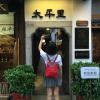Serendip is an independent site partnering with faculty at multiple colleges and universities around the world. Happy exploring!
You are here
Home » Web Paper or Special Event
By hannah
November 17, 2016 - 16:24
Monique Truong titles Bình’s narrative The Book of Salt -- and salt, at least the fleur de sel that Bình discovers during the book, is described as “a gradual revelation of its true self… there is a development, a rise and fall, upon which its salinity becomes apparent, deepens, and then disappears” (98). Like salt, then, this book and its stories are also a gradual revelation of self. Through the tale of the basket weaver and the water hyacinths, Bình unfolds a narrative about himself and the theme of home.
November 17, 2016 - 09:30
Intersectionality is a theory that examines “the intersecting patterns” of systems of oppression (Crenshaw). It is a framework that accounts for the intersections of identities, such as race, gender, sexuality, class, ability, etc., which overlap and inform the experiences of people who are of multiple marginalized identities. It is an analytical tool that addresses the layers of identity that accumulate and form a wholeness, and recommends that this wholeness be approached with respect to all the social categorizations that are applied to different bodies.
November 15, 2016 - 07:14
“‘Good riddance,’” says Billy Beede, the main character of Suzan-Lori Parks’s novel Getting Mother’s Body, after watching her mother, Willa Mae Beede, die from an attempted abortion (Parks 37, 112). But six years later, Billy is still not “rid” of her mother; she is haunted by Willa Mae’s words and lifestyle, and by the fear of following in her footsteps. Meanwhile, Billy’s childless aunt and uncle have tried to raise her as their own, but Willa Mae stands between them.
November 14, 2016 - 15:23
Last year in December, Obama had passed banned microbeads that are inside cleansers and shower gels. These beads do not dissolved because they are plastic therefore, when they wash down your drain and in the ocean fish are mistaking them food for food, eating them, and dying. Microbeads had also contributed to a greater increase in microplastic pollution, and could not exactly be cleaned out of the ocean due to is extra small size.
November 13, 2016 - 23:58
Silence, Language and Expertise in The Book of Salt
November 13, 2016 - 20:06
All Over Creation explores the roles of belief and practicality in determining groups relationships to the environment. On one hand are the potato farmers who believe they have no choice but to use genetically modified seeds, on the other hand are the ‘Seeds of the Resistance’ an activist group advocating for GMO labeling. The third group are the residents of Liberty Falls who never confront the issue but object to the Seeds presence and their way of life. The three groups in Ozeki’s novel seem irreconcilably at odds but and the story begs the question if there’s any way for them to come together.
November 13, 2016 - 16:44
“It starts with the earth. How can it not? Imagine the planet like a split peach, whose pit forms the core, whose flesh its mantle and whose fuzzy skin its crust-no, that doesn’t do justice to the crust, which is, after all, where all life takes place” (p.1). All Over Creation by Ruth Ozeki is a novel that advocates for non-chemical agricultural methods. Besides the enormous family drama involved, it is also cornered at agribusiness and environmental activism. The seeds of resistance, an irrepressible eco-activist group, spawned protest In regards to genetically engineered foods. They stormed supermarkets and even went ahead to uproot the planted inorganic plants at Will’s farm.
November 13, 2016 - 16:03
While feeling heavy and a little desperate after reading this book, I keep thinking what caused the tragedy of human beings. As the question raised by the author, “How did these wealthy nations—rich in the resources that would have enabled and orderly transition to a zero-net-carbon infrastructure—justify the deadly expansion of fossil fuel production?” (p.22), the most confusing part in this tragedy is, in my view, when we clearly see the consequence of it and actually have the ability to stop this tragedy, why we still keep doing harm to the earth?
November 13, 2016 - 13:43
Living in the peaceful and resourceful twentieth century, we learned history of how dinosaurs went into extinction, how Maya Civilization came to an end and all the other civilization that no longer exist, but we never think of the way and the time of the collapse of our own civilization, and how the later civilization would view us. In the book “The collapse of western civilization”, the authors picture the world that is devastated by climate change and how people keep holding their traditional “empirical” ideology and accelerate the coming of catastrophe.
November 12, 2016 - 22:35
The article talks about the worry and fear that took over the diplomats, activists, and youth groups that attended the annual UN climate conference when they got word that Trump, a known climate change unbeliever, won the presidency. Many are worried about the possibility of the US withdrawing from the Paris Agreement, which agrees to limit global warning, especially since the US's withdrawal would signal other countries to not meet their voluntary pledges and since it may ruin relations with China. There are those who are optimistic about the situation and believe that it would be too messy for Trump to actually withdraw from the treaty and that one man would not be able to destroy all the climate progress the world has achieved.










